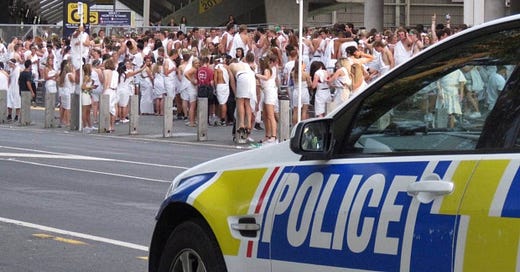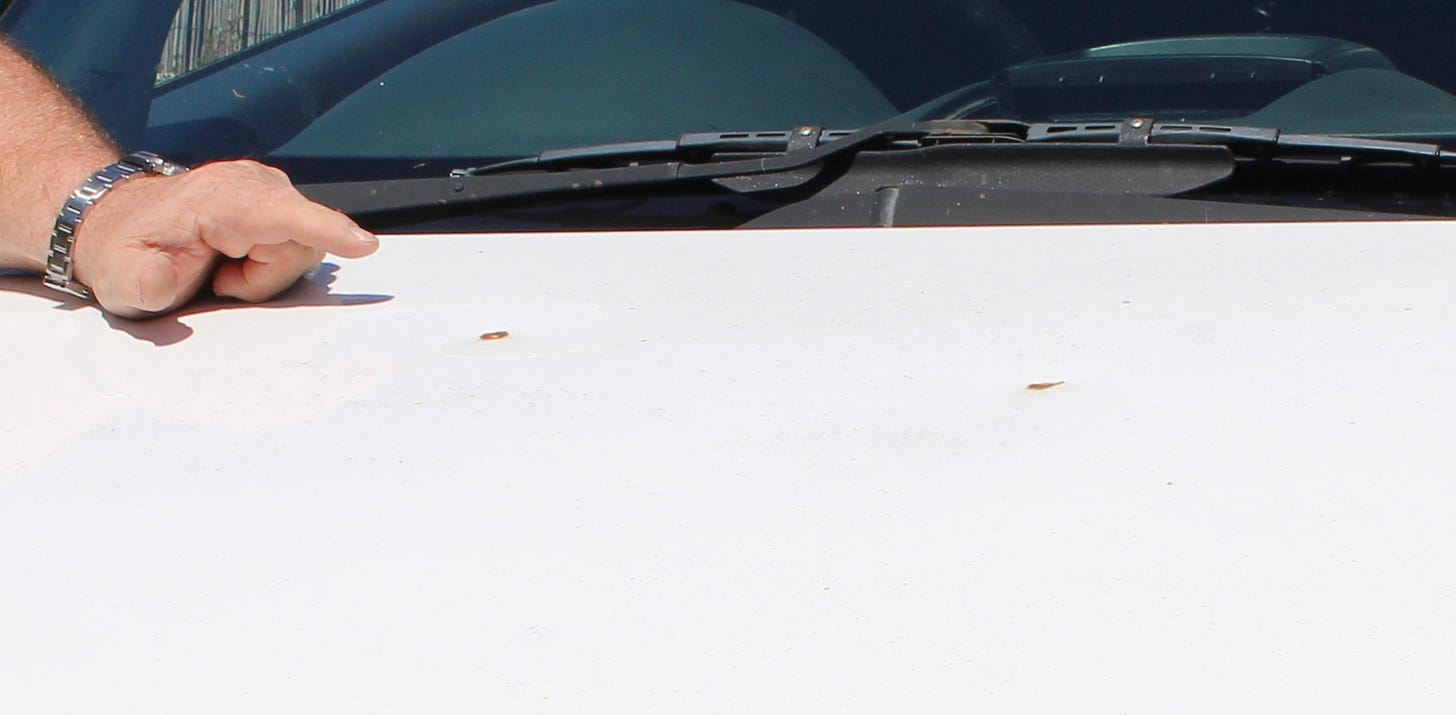Tale of two (Dunedin) criminals
While a former notorious murderer is dead, a jailhouse lawyer turned bestselling author remains larger than life
Welcome to The Mish.
As part of my job as a Dunedin-based reporter I keep an eye on how stories perform online.
Some stories do well, some don’t. That’s just the nature of news.
While the story you bust your gut on can sometimes die without a trace, the lighthearted one about some student hijinx goes gangbusters.
Toga clad first year students gather outside Forsyth Barr Stadium: Photo: Hamish McNeilly
I get it, but it doesn’t stop reporters from wanting to write the former.
But a curious thing has happened in recent years.
Every week I spot that someone has been reading a certain series of stories I wrote years ago.
Well, I’ve got an update. After four long years.
But, firstly, this newsletter is unashamedly about Dunedin, New Zealand’s greatest city, and the people in it - warts and all.
No matter where I go in New Zealand people tend to reference three things about Dunedin: students, weather and crime.
I understand the first two; I’ve covered more student stories than couch fires on Castle St and I’ve conceded that Dunedin’s weather is somewhat temperate.
But crime?
The city has one of the lowest crime rates in New Zealand. I remember moving south over two decades ago and having the vehicle insurance bill drop by almost a half.
But the public perception of crime and Dunedin is something completely different.
The Bain murders, the Aramoana shooting, the Mosque gunman, Clayton Weatherston, Christopher Lewis, Colin Bouwer, Venod Skantha: all of these high profile cases are forever linked with Dunedin.
This week The Mish has an update on one of those cases: Colin Bouwer.
The New Yorker once wrote of Bouwer, the former head of the University of Otago Department of Psychological Medicine: “Even in Dunedin, however, a psychopathic psychiatrist stands out’’.
His wife Annette died on January 5, 2000.
It was later found she was poisoned.
Bouwer was arrested nine months later after a lengthy police operation, including wiretaps on his phone.
Colin Bouwer as the jury delivered its verdict. Photo: Stuff
That investigation led to a court case so compelling that a jury took less than three hours to find him guilty of murdering his wife.
He was sentenced to a minimum non-parole period of 15 years and had fought-off a deportation order to his native South Africa in 2001.
But that wouldn’t last.
Despite Bouwer developing kidney disease, his appeal to stay in New Zealand was denied, and he was deported back to South Africa in October 2017.
And that was the last the world heard anything of Bouwer. Almost every week I would see that people continued to re-read stories about his parole hearings which ended in his deportation.
Efforts to track him down by a South African media outlet also proved fruitless, and the world moved on.
Colin Bouwer and his long-serving lawyer David More outside court. Photo: Stuff
The four years of silence is partly because he has been dead for three of them.
Sources confirmed that Bouwer died at Ramsgate in Kwazulu-Natal on August 15, 2018, just two weeks short of his 68th birthday.
He died of natural causes.
As an aside Immigration New Zealand confirmed Bouwer never repaid any of his outstanding deportation costs of $10,174.40.
While he was one of Dunedin’s more infamous residents, that title would probably go to Arthur Taylor, a likeable larger-than-life character, who has spent almost four decades behind bars.
This year Taylor, who never spent time alongide Bouwer, published Prison Break: The extraordinary life and crimes of New Zealand’s most infamous escapee.
Earlier this year, and before his book ended-up on the bestseller list, Taylor bought a new car.
Not just any car - this is Arthur Taylor, after all - but a former police vehicle: a V6 Holden Captiva complete with personalised plate: XDBLOK - a nod to his time at Paremoremo, which houses the country's most dangerous criminals.
Arthur Taylor with his Holden Captiva. Photo: Hamish McNeilly
The jailhouse lawyer turned best-selling author gave a tour of the station wagon.
“It is quite well-known, this plate,” Taylor, who kept the plate in storage while he served time, said.
But what isn’t well-known was how two bullet holes, now with slight rust marks around the edges, ended-up in that bonnet.
Its first registered owner was indeed the New Zealand Police, with the vehicle based in the Southern Police District from 2007 to 2017, where it clocked up almost 200,000km.
“A mate of mine had an ex-police vehicle before . . . they have bloody good suspension. They are well maintained,” Taylor said.
The vehicle had been stripped prior to when police sold it, but a wired-in electronic device designed to open a police garage gate had been left in it.
He’d never tried it because “they would probably lock me in there”.
While he had not been pulled over in the vehicle – Taylor was limited to only travelling in Dunedin due to bail conditions – a female friend had.
The vehicle, which was missing a few internal panels after police removed the electronics, caught the attention of a police officer.
“Highly suspicious,” the officer reportedly told Taylor's friend.
Taylor said the person he bought the vehicle from had kept it in storage for a year, but told him it may have been involved in a high profile case of an offender who went on the run after stealing a police car and two glocks.
The two holes on the former police car bonnet. Photo: Hamish McNeilly
“That’s the story he told me.”
But that unfolded two years after the vehicle was sold.
Police also couldn’t shed light on the vehicle, as they did not keep records of all incidents a police vehicle attended.
A frontline vehicle could attend thousands of events over its time with the New Zealand Police fleet, the police spokesman said.
But police did search their records for any incident involving the vehicle when it was part of their fleet under its former registration plate.
There was no record of it being damaged by a firearm, the spokesman said.
It was unlikely police would have disposed of the vehicle with that sort of damage, he said.
The ‘sensor’ on the vehicle had also been deactivated when it was decommissioned from the police fleet.
But it can be revealed that the vehicle had been used in at least one other high profile case, courtesy of Taylor, who used it to bring in a fugitive.
That story made worldwide headlines after Taylor and his legal advocate Hazel Heal helped charter a helicopter to return the wanted man to police custody.
Arthur Taylor brings in the wanted fugitive to the Dunedin Central Police Station: Photo: Hamish McNeilly
The trio had a meal of oysters and quaffed champagne before later driving to the police station in the former police vehicle.
I don’t know what music they listened to on their trip back to Dunedin, but here’s a great track from local band Death and the Maiden.
This week is shaping up as a big one for Jane Campion’s The Power of the Dog which was shot in Dunedin and Otago before the global pandemic took hold in 2020.
I’m looking forward to seeing it on the big screen as part of the New Zealand International Film Festival. I’ve heard a whisper a scene featuring the city’s iconic railway station may not have made the final cut. I’ll keep you posted.
Speaking of the railway station, which is undergoing restoration completely hidden behind a temporary mesh facade, here is my Dunedin tweet of the week.


See you next week.













Very interesting! I went to an open house in Seacliff last weekend and learned all about a murder that occurred there! Grisly stories abound in Dunedin!